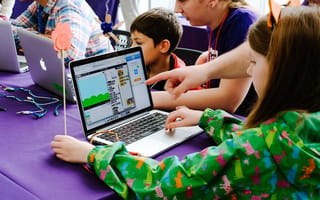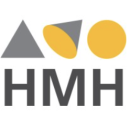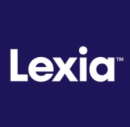Technology has disrupted everything from healthcare and banking to transportation and printing. Now it’s gunning for that staple of childhood: blocks.
For a lot of kids, blocks on the floor have been replaced by virtual blocks on a screen. And instead of using them to build castles, they’re using them to learn coding courtesy of a LEGO-inspired programming language called Scratch.
Designed for kids ages eight to 16, Scratch was created by the Lifelong Kindergarten Lab at MIT and originally released in 2007. (A simpler version, Scratch Jr., caters to younger users.) Its mission: to facilitate earlier and more in-depth tech education.
“We need to expand the notion of ‘digital fluency’ to include designing and creating, not just browsing and interacting,” Scratch’s inventors wrote in 2009.
Over the past decade, that view has gained mainstream traction, as evidenced by the company's more than 40 million registered users in and out of schools.
Over at UC Irvine’s Digital Learning Lab, Dr. Mark Walschauer and his team are using funding from the National Science Foundation to design a Scratch curriculum for early elementary-age kids. Walschauer is particularly fond of Scratch’s user-friendly language. Its block structure, he says, makes typos (common in kid coding) impossible. On top of that, its media-friendly interface lets kids incorporate cat photos and their own voices in programming projects.
More broadly, Walschauer appreciates that teachers increasingly employ technology in elementary classrooms.
“I’m a firm believer in developing computational thinking in schools,” he told Built In, “because I think computation is such an important part of all careers.”
Edtech Companies to Know
- Paper
- Houghton Mifflin Harcourt
- Mind Research Institute
- Lexia
- Amplify
- Flocabulary
- Enuma
The Screentime Conundrum
Edtech is a multi-billion-dollar industry, and the growing preK-12 software market is currently worth more than $8 billion. Digital tools abound to help kids with reading, writing, basic math and other subjects. In Southern California schools, especially, Dr. Walschauer often sees tablet and laptop carts in elementary classrooms.
But the combo of elementary-age kids and screentime is a fraught subject for many. Detractors say it’s unhealthy. And it’s true that researchers have scant data on how screens impact kids’ highly malleable brains in the long term. In the spirit of caution, the World Health Organization recently recommended an hour or less of daily screentime for kids under five. “Less,” the group added, “is better.”
Dr. Marilyn Price-Mitchell, a developmental psychologist who studies the impact of technology on young people, seconds the WHO’s sentiments. As technology has become more prevalent over the past few decades, she notes, robust longitudinal studies have found a decline in empathy among college students.
“We don’t really know what the cause of that decline is,” Dr. Price-Mitchell told Built In, “but we know that children are spending less face-to-face time with humans.”
But their face-to-screen bonding has greatly intensified.
Elementary educators, then, must deal with a conundrum: preparing kids for a hyper-connected world while simultaneously encouraging healthy human development. The latter requires in-person interaction, not coding savvy.
Price-Mitchell and Walschauer agree, however, that tech can play an important role in elementary classrooms by augmenting educational toolkits rather than dominating the curriculum.
We’ve rounded up companies finding creative ways to integrate technology in the elementary classroom.
Location: New York, New York
TPT operates a digital marketplace for educational resources that cover a broad range of grades, including elementary school. Teachers look to TPT to find worksheets, grading rubrics, posters and other classroom materials. More than 7 million educators globally rely on TPT’s teaching resources to help them build lesson plans and enhance the learning environment.
Location: Chicago, Illinois
Elevate K-12 focuses on technology solutions to alleviate teacher shortages. It connects K-12 classrooms with teachers who deliver live lessons via an online platform. The company’s teachers are able to handle subjects like math and English language arts for elementary school students.
Location: Montreal, Quebec
Paper, a remote-first edtech platform, partners with elementary schools throughout the U.S. and Canada to provide tutoring services at no cost to families. Paper tutors can help students in a variety of languages from English and Spanish to French or Mandarin. Tutors are also available to students 24/7 using the company’s live help chat feature. The company also offers a number of online tools to help elementary-school students with reading and math proficiency.
Location: Boston
How it’s shaping elementary edtech: The storied textbook publisher also developed iRead, a digital literacy program designed to get every student reading by third grade. As part of the program, which is backed by a multi-school-district study, kids send digital avatars to virtual classes that automatically adapt to their strengths and weaknesses.
Location: Irvine, CA
How it’s shaping elementary edtech: This non-profit organization makes ST Math, a math-instruction program whose vibrant world teems with penguins and rainbow balloons. Reportedly used by 1.2 million elementary-age students, the program promotes deep conceptual understanding over mere memorization.
Location: Concord, MA
How it’s shaping elementary edtech: Designed in accordance with the latest pedagogical research, Lexia’s CORE5 literacy platform cuts testing out of the reading process. Instead, the interface assesses K-5 students as they read, and the adaptive lessons—focused on building blocks like phonetics and comprehension—find and fill in competency gaps as they appear.
Location: New York City
How it’s shaping elementary edtech: Amplify has helped modernize elementary school instruction and assessment for a couple of decades now. Its teacher-friendly tech tools cover a variety of subjects, including reading to science. The company also offers course sequences on more specific topics like fractions and English-language acquisition.
Location: Brooklyn, NY
How it’s shaping elementary edtech: Kids use Flocabulary to learn new vocabulary words from video lessons that feature hip-hop-style songs. The catalog covers K-12 science, math and English terminology, and teachers can reinforce new lingo with worksheets and other app-based assessments.
Location: Berkeley, CA
How it’s shaping elementary edtech: Enuma’s signature app, Todo Math, features more than 40 multi-level math games in which kids master Common Core concepts and earn cyber-stars for correct answers. Like all of the company’s apps, Todo Math welcomes kids of all abilities. It even has a special font for dyslexic readers and tools for circumventing fine motor skill challenges.
The Future of Elementary School
Walschauer, for one, sees a few especially promising elementary edtech tools on the horizon. There’s formative assessment technology, which Lexia and other edtech companies use to assess learning as it happens. By making summative assessments (like testing) redundant, it could help decrease the stress and shame that often accompanies them.
In a similar vein, Walschauer is excited about the surge of personalized tech tools for kids with special needs. Even the mere presence of a computer, he says, can foster an atmosphere of greater inclusion. As one example, he refers to the time he witnessed an autistic 10-year-old bond with a classmate on a laptop-based project.
“To just to sit there and talk was too painful and too difficult,” he says, “but when they were working together on the computer, showing each what they had done, [the screen] provided a nice bridge for the [autistic] student to communicate a lot more.”
For her part, Price-Mitchell wants edtech companies to incorporate holistic measures like empathy in addition to the narrow numerical measures they already focus on – like the number of fraction-based math problems a child correctly solves. Without empathy, she says, kids can’t apply their mechanical skills — such as those sharpened by video games — to the “social and environmental problems of the world” in an exciting or meaningful way.
But empathy grows from meaningful human connection and face-to-face interaction. Which isn’t to say every glance at an app is a step towards sociopathy, but both Price-Mitchell and Walschauer agree: No online elementary schools, please.
“When we eliminate the human interaction, particularly in young people’s learning,” Price-Mitchell says, “we have to ask ourselves the question: how will it affect these children in their development of broader, much more important human characteristics like curiosity or creativity or empathy or resilience?”
Learning First, Gadgets Second
There’s at least one thing on which both Price-Mitchell and Walschauer agree when it comes to the future of elementary education: “blended learning.” A mix of in-person traditional instruction and independent work with technology, it is most effectively implemented by tech-savvy teachers who ensure that edtech serves academics and not vice versa.
“I remember one class where teachers assigned students to do a PowerPoint,” Walschauer said, “and [the students] got a grade based on how many transitions, colors and different formats they used. In other words, [the assignment] was: Create a PowerPoint from hell.”
That’s exactly the wrong way to combine education and tech, he says. The students learned about the tool itself, PowerPoint, but didn’t use it to meet their academic or developmental needs.
When it’s deployed smartly, though, edtech can meet a variety of elementary educational needs. Snapping together Scratch's blocks, for instance, teaches kids more than how to use Scratch — it teaches them modes of reasoning relevant to every programming language.
And just as she hopes edtech companies will focus more on holistic measures, Price-Mitchell also wants schools to take a more holistic approach by incorporating technology “into the other things that we know humans need, like time to reflect and discuss with their peers and teachers. Kids could also use tech to reflect on the feeling of learning, or to catalog what sparks their curiosity.”
Despite a flood of untested edtech gadgets, however, Walschauer says there's a trend toward familiar and versatile basics like Google docs and spreadsheets — “the kinds of things that you and I use to share, to write, to do research, to share work together.”
In edtech as in all tech, sometimes less is more.













